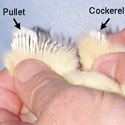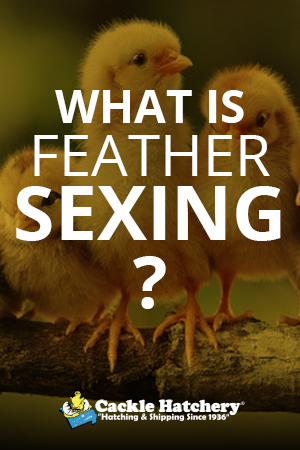
Feather sexing is the ability to determine the gender of a newly hatched chick based on the rate of growth of its wing feathers. The trait is sex linked and works only if the chick’s father is of a breed that grows feathers rapidly and its mother is of a breed that grows feathers slowly.
The more commonly known sex links are sexed at the time of hatch by the color of their down — the down of the pullets is one color or pattern, while the down of the cockerels is of a different color or pattern. Examples of well-known color sex links are red sex links (at the time of hatch, pullets are buff/red, cockerels are mostly white) and black sex links (pullets are solid black, cockerels are black with white head spots).
Sex linkage works because the genes in question — whether for plumage color or rate of feather growth — are carried on a chicken’s sex chromosomes. A rooster’s two sex chromosomes are both the same, and are designated as ZZ. The hen’s two sex chromosomes differ from one another, and are designated as ZW.
As it turns out, Z chromosomes carry nearly all the sex linked genes. Because a pullet gets her single Z chromosome from her male parent, she inherits sex linked traits only from the father’s side. A cockerel, on the other hand, gets one Z chromosome from each parent, and therefore inherits sex linked genes from both father and mother.
Rate of feathering, as well as some of the genes that govern plumage color, is carried on the Z chromosome. When a rooster with two genes for rapid feathering is mated with a hen that has a gene for slow feathering, all the offspring pullets will inherit a single rapid feathering gene from their father. The cockerels, on the other hand, will inherit both a slow feathering gene from their mother and a rapid feathering gene from their father, and since slow feathering is dominant, the cockerels will feather more slowly than their sisters.
After the chicks hatch and their down has dried, by examining the two rows of feathers at the edge of the wings, you can easily see that the pullets’ primary feathers (the row closest to the wing’s edge) are longer than the coverts. The cockerels, on the other hand, have primary feathers that are shorter than the pullets’, and about the same length as the coverts.
This method of sexing chicks requires little training and has an accuracy rate of 90-99 percent, depending on the bloodlines. But the difference in the growth of the primary feathers occurs only between one and three days of age, after which the cockerels’ wing feathers catch up with the pullets’ and they all look alike.
Feather sexing is commonly used by the broiler industry — where white-feathered birds are preferred — to facilitate raising the slow-growing pullets apart from their faster-growing brothers.
The broiler industry accomplishes this by developing two different breeding lines, one for rapid feathering and one for slow feathering. Hatcheries, too, maintain double lines of some breeds to simplify, and improve the accuracy of, sexing chicks to be shipped to customers.
If you want to try this for yourself just for fun, or as a school science project, some of the rapid feathering breeds are Andalusian, Campine, Leghorn, Marans, and Minorca. Some of the slow feathering breeds are Cochin, Plymouth Rock, Rhode Island Red, Sussex, and Wyandotte.
You may run across websites where people claim any chick may be feather sexed. But, as you now know, that’s simply not true. A chick can be feather sexed only if its mother is slow feathering and its father is fast feathering. Furthermore, you can’t get feather sex chicks by mating a feather sex rooster to a feather sex hen. It works only for the first generation.
And that’s today’s news from the Cackle Coop.
Gail Damerow, author, The Chicken Encyclopedia



I’m surprised you don’t address any of the autosexing breeds in this article. While autosexing is not quite identical to feather sexing, it does rely on different feather coloration from male to female, and is 100% accurate.
Hi James,
Autosexing was covered in this blog post: https://www.cacklehatchery.com/whats-the-difference-between-sex-link-and-autosex-chickens/
I got rhodeisland whites from cackle hatchery.just started laying.my question is if I hatch from the rhodeisland whites.can I sex them when they hatch if so what do I look for.
I like chickens too!